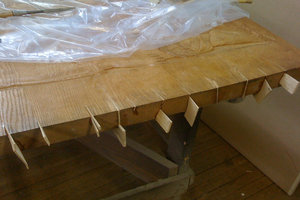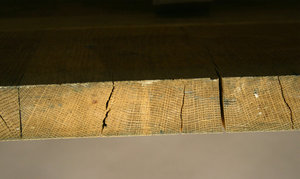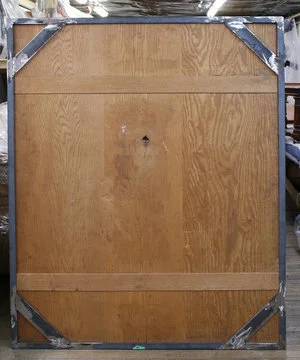Malvina Cornell Hoffman (1885-1966), an American sculptor who studied with Auguste Rodin, is perhaps best known for her monumental bronze series, The Races of Mankind, commissioned in 1930 by Chicago's Field Museum of Natural History. In 1985, The Cedar Rapids Museum of Art accepted Hoffman’s Pietà (1960) as a gift along with other notable pieces. The Pietà, carved on a walnut panel, (54¼” H x 42¼” W x 3” D) had never been exhibited at CRMA, but in 2008 was exposed to flood waters, and rediscovered during the conservation treatment.
Malvina Hoffman, Pietà, 1960, Wood Relief (before conservation treatment)
In the late summer of 2008 the Midwestern United States endured some of the worst flooding in recent history. Several area homes, institutions and museums had to be evacuated as the rivers rose. The Cedar Rapids Museum of Art was one of many institutions whose collection was in danger of the rising waters. Although much of the collections contents were removed unharmed, some pieces suffered exposure to high levels of humidity, moisture and other environmental conditions related to the severe flooding. With the help of trained art handlers and conservators from Conservation and Design International from Chicago, Illinois, all of the items in danger and damaged were removed from the pending threat and brought to a secure location for proper cleaning, treatment and storage. Of the many items treated and cleaned, one provided us with an example of how high levels of humidity and exposure to moisture can affect the stability of a carved composition in a solid wood panel.
Malvina Hoffman’s Pieta was exposed to rising levels of relative humidity (RH), temperature change and standing water. The panel is constructed out of three separate members of solid walnut, glued together and joined in the back by two mortises and tenons. Wax had been applied to the surface and evidence of the artist’s original penciled layout was still visible along Mary’s hand and Jesus’ face. Due to the increased RH and changing temperature, several sections of the oak end grain began to expand causing the edges of the panel, at both the top and bottom, to develop expansion cracks which stretched inward along the grain towards the intricately carved center. The water stained areas on the surface generated a white cloudy haze where wax had built up in the relief carving. The sections of the panel had sustained abrasions and dents along the sides, sections of the wood had become stained by oils and residues, and the bottom edge showed evidence of minor mold development. All of these issues were noted in a condition report and a treatment was designed to correct the defects and conserve the panel.
Documented onsite condition; back of panel
The first step in the proposed treatment was to stabilize the panel and allow the moisture in the wood to slowly level off. The composition remained in a climate controlled room with an adequate RH level for four weeks. The expansion cracks were monitored and measured periodically to ensure that further separation ceased. Once the cracks had stabilized, filler was needed to compensate for the open gaps. Shims of balsa wood were cut and sized to fit in each of the individual areas. The balsa wood shims were then coated on one side with a PVA (plasticized polyvinyl acetate) and pressed into place and trimmed flush to the panel edges.
The next step in the conservation process was to remove the existing wax, stains and oily residue from the surface. Solutions based with alcohol, ether & naphtha were applied to the surface and then gently washed over. The original pencil sketching was carefully avoided during these processes to maintain the original composition. A PH neutralizing detergent and a final rinse wash were the last steps in cleaning. With the surface clean and free of invasive matter, water based pigments were applied to the balsa wood in-fills to match the existing oak panel. The abrasions and dents were also toned to match the surrounding areas to provide a uniformed aesthetic surface. The last treatment related to surface conservation was to apply a protective Paraffin wax layer over the panel. This wax was melted to forty-eight degrees Celsius and applied by brush onto the panel. Once the wax cooled it was hand rubbed with a cotton cloth to produce an even and low luster finish. This wax application will provide additional protection to the composition from dust and or other residues from penetrating the surface.
Before conservation
After conservation
The final step involved in conserving the Hoffman panel was to fabricate a steel frame that would control the movement of the wood and allow for adequate and safe exhibition upon its return to the Cedar Rapids Museum of Art. A frame was fabricated out of mild-steel and welded together to fit the perimeter of the panel and remained recessed from the front face edges. The recessed profile was a small detail but important as not to distract the viewer from the composition. The frame was painted a flat black color and rubber cushions were installed where the panel rests against the frame. The frame was fastened to the back side of the panel using the existing holes from previous installations. The treatment was complete at this stage.
Balsa wood infills
Balsa wood infills
Expansion cracks in the bottom section of the panel
Balsa wood infills in the expansion cracks
Metal frame fabricated and fitted around panel to prevent any future warping movement










